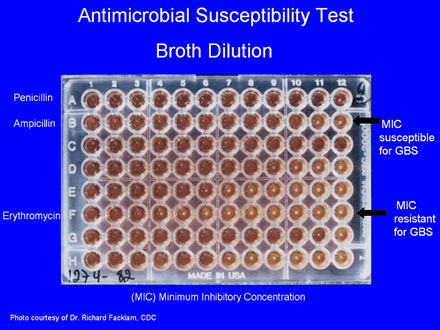Laboratory Personnel, Slide 10
Antimicrobial Susceptibility Test
(Broth Dilution)

This test used to test all the ABC isolates. This picture shows the most accurate method of determining the antimicrobial susceptibility of GBS. This test is called the broth dilution antimicrobial susceptibility test. It is standardized by the the National Committee on Clinical Laboratory Standards (NCCLS). The picture above shows a microtiter plate with 96 wells. There are 8 rows of wells, labeled A through G. Each row of wells contains one antibiotic. In each row there are 12 wells. Each well contains a different concentration of the specific antibiotic, usually doubling dilutions. In this case, row A contains penicillin starting at the right at 16 ?g/ml and reducing to 0.008 well 12. Row B contains ampicillin starting in well 1 with 16 ?g/ml and reducing to 0.008 ?g/ml to well 12 in the same row. The other rows contain different antibiotics. All 96 wells are inoculated at the same time and the panel is incubated overnight (20-24h). The next day the wells are examined for growth. If there is growth in the well, the antibiotic did not inhibit the bacteria. If you take a close look in row A you will see growth (a small white button at the bottom of the well) only in well 12. In row B you see growth in both well 11 and 12. This means the minimum inhibitory concentration (MIC) of penicillin is 0.016 ?g/ml and the MIC for ampicillin is 0.032 ?g/ml. The MIC’s of these antimicrobials are considered susceptible for,GBS. Erythromycin is shown is row F. The concentration of erythromycin starts at 32 ?g/ml in well 1 and goes to 0.016 ?g/ml in well 12. You can see that there is growth in wells 12 to 4, meaning the MIC of erythromycin to this strain is 8 ?g/ml. This MIC is considered resistant for GBS. Since this is a standardized test results can be compared world-wide if the standard procedures are used. Consult the NCCLS manual for reporting interpretive standards (sensitive, intermediate, and resistance).NCCLS Performance Standards for Antimicrobial Susceptibility Testing; Twelfth Informational Supplement: M100-12 (2002) M2-A7 and M7-A5.
Page Last Modified: April 20, 2008
Content Last Reviewed: April 20, 2008
Content Source: National Center for Immunization and Respiratory Diseases
